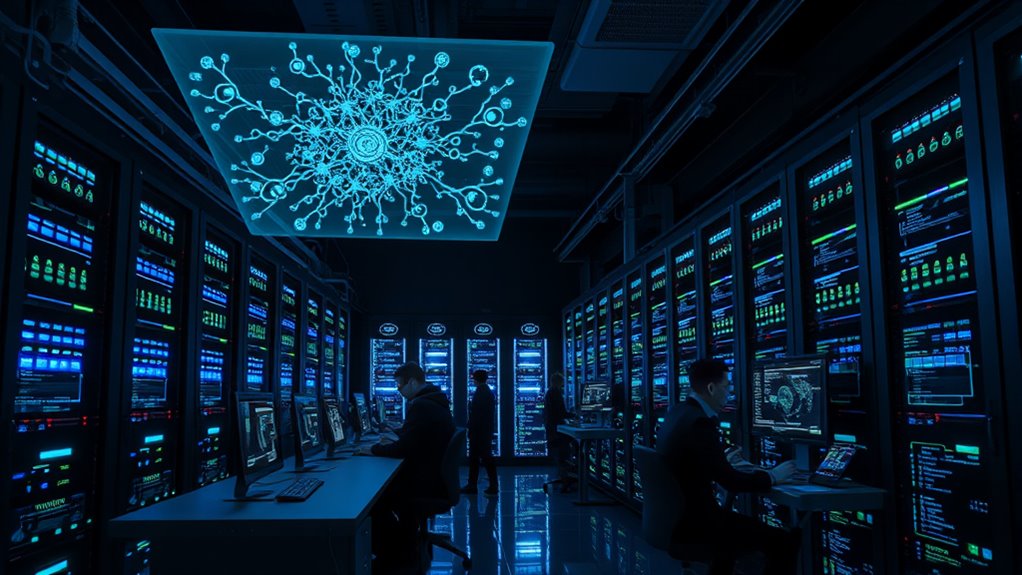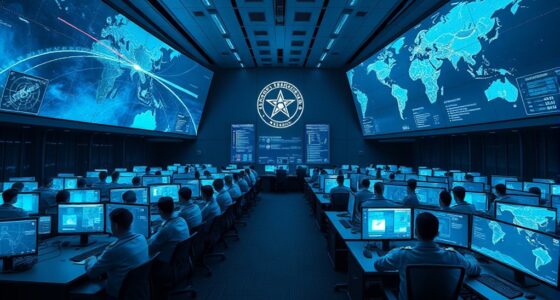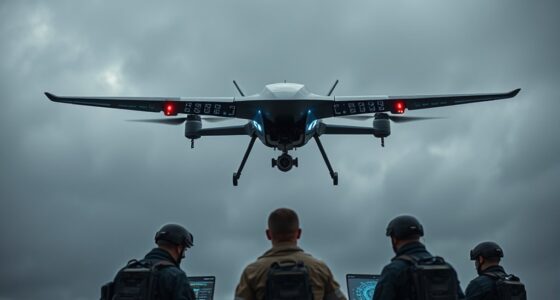Inside the NSA’s AI lab, you find cutting-edge systems that analyze massive data streams to detect threats, decode communications, and guarantee national security. They develop machine learning models for pattern recognition, anomaly detection, and real-time threat alerts. These tools parse multiple languages, analyze encrypted messages, and track cyber activities, all while respecting privacy and security boundaries. If you explore further, you’ll uncover how these advanced systems keep the country safe behind the scenes.
Key Takeaways
- Develops advanced algorithms for pattern recognition, threat detection, and decoding encrypted communications.
- Builds AI systems that analyze large data sets in real-time to identify suspicious activities.
- Creates machine learning models to improve intelligence collection, prediction, and threat analysis.
- Implements natural language processing and image recognition for multilingual and multimedia data analysis.
- Ensures security, privacy, and ethical compliance while enhancing national security capabilities.

Have you ever wondered how the NSA stays ahead in the digital age? The answer lies partly in its AI lab, a high-tech hub where cutting-edge algorithms and machine learning models are developed to tackle some of the most complex intelligence challenges. Inside this lab, the focus isn’t just on creating new software; it’s on building systems that can analyze vast amounts of data, identify patterns, and uncover threats before they even fully form. You might think of it as a digital detective agency, where AI tools sift through terabytes of information to find clues that humans might miss. This process involves sophisticated natural language processing, image recognition, and anomaly detection techniques designed to operate at scale and speed impossible for manual analysis.
NSA’s AI lab develops advanced systems to analyze data, detect threats, and stay ahead in national security.
In the NSA’s AI lab, you’ll find a blend of computer scientists, data analysts, and engineers working together to push the boundaries of what artificial intelligence can do. They build models that can read through encrypted communications, parse multiple languages, and flag suspicious activity in real-time. These systems don’t just passively analyze data—they adapt and improve through machine learning, continuously refining their accuracy and efficiency. For instance, they develop algorithms capable of detecting cyber threats, tracking terrorist communications, or even predicting future attacks based on emerging patterns. The goal isn’t just to keep up with cyber adversaries; it’s to stay several steps ahead.
You also need to understand that the NSA’s AI lab prioritizes security and privacy at every turn. The tools they develop are designed to operate within strict legal and ethical boundaries, ensuring that sensitive data is protected and that surveillance is targeted and justified. This involves creating encryption-breaking capabilities, as well as methods to decrypt or analyze communications when necessary. They work on building AI that can sift through encrypted messages without compromising privacy standards, a challenging feat that combines cryptography and machine learning expertise. The lab’s work is also about resilience—developing systems that can withstand adversarial attacks designed to fool AI models and evade detection. Additionally, the integration of advanced cybersecurity techniques helps safeguard these systems from malicious interference.
Ultimately, what they build inside the NSA’s AI lab isn’t just about technology—it’s about strategic advantage. The systems they develop give the agency a technological edge in national security, helping to prevent threats before they materialize. So, next time you think about AI, remember that behind the scenes, the NSA’s AI lab is quietly constructing the digital tools that help keep the nation safe.
Frequently Asked Questions
How Does NSA Prevent AI From Infringing on Privacy Rights?
They keep a close eye on AI to prevent infringing on privacy rights, so you’re not caught off guard. By implementing strict data access controls, encryption, and regular audits, they guarantee AI only processes relevant information. They also develop algorithms with built-in privacy safeguards, so you don’t have to worry about your data going astray. It’s a delicate balancing act, but they know how to walk that tightrope effectively.
Are Nsa’s AI Projects Ever Shared With Other Government Agencies?
Yes, the NSA often shares its AI projects with other government agencies to enhance national security efforts. You might not see all collaborations publicly, but they work closely with agencies like the CIA and FBI. This sharing helps streamline intelligence operations and improve data analysis capabilities across agencies. However, they still maintain strict confidentiality and oversight to safeguard sensitive information and ensure privacy rights are respected.
What Are the Ethical Guidelines for Nsa’s AI Development?
You might feel uneasy about the NSA’s AI work, but their ethical guidelines focus on security and privacy. They aim to balance national safety with respecting individual rights. You can trust that they follow strict protocols, including oversight and transparency where possible. While their work is secretive, their commitment is to develop AI responsibly, ensuring their actions serve the greater good without crossing moral boundaries.
Can Nsa’s AI Be Used for Commercial Purposes?
You can’t typically use NSA’s AI for commercial purposes, as their technology is classified and strictly for national security. The NSA’s AI systems are designed for intelligence, surveillance, and security operations, not commercial applications. If you’re interested in AI for business or public use, you should explore commercial AI providers that develop tools specifically for that market. Using NSA’s AI outside their scope is illegal and poses serious security risks.
How Does NSA Ensure AI Security Against Adversarial Attacks?
You might be surprised, but the NSA secures AI against adversarial attacks through layered defenses. They continuously test models for vulnerabilities, employ robust algorithms, and use real-time monitoring to detect anomalies. When threats are identified, they adapt quickly, updating systems to block malicious inputs. This proactive approach guarantees their AI remains resilient, maintaining integrity even when faced with sophisticated adversarial tactics.
Conclusion
So, now that you’ve seen what the NSA’s AI lab is really working on, do you ever wonder what secrets are just beyond your reach? With cutting-edge technology shaping national security, it’s clear that their innovations could change everything—and maybe even your own future. As AI continues to evolve, one thing’s certain: the line between what’s seen and unseen is getting blurrier every day. Are you ready to face the implications?









